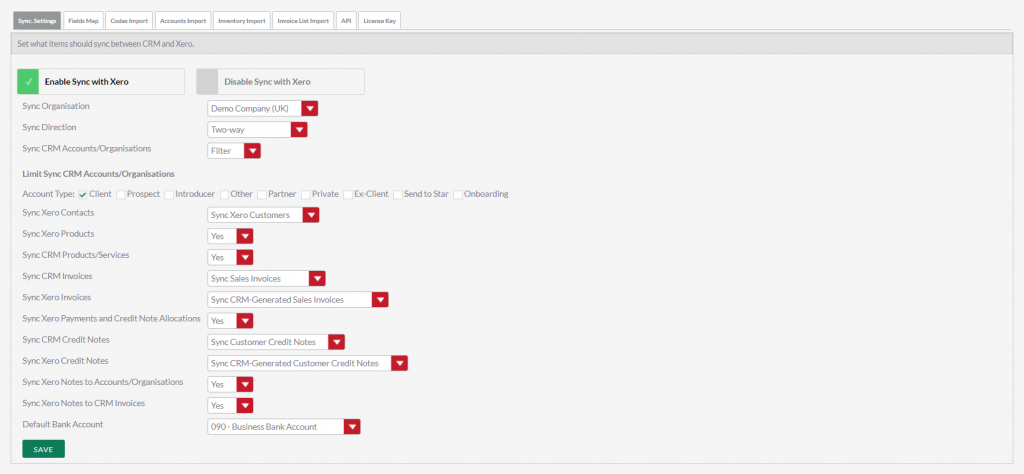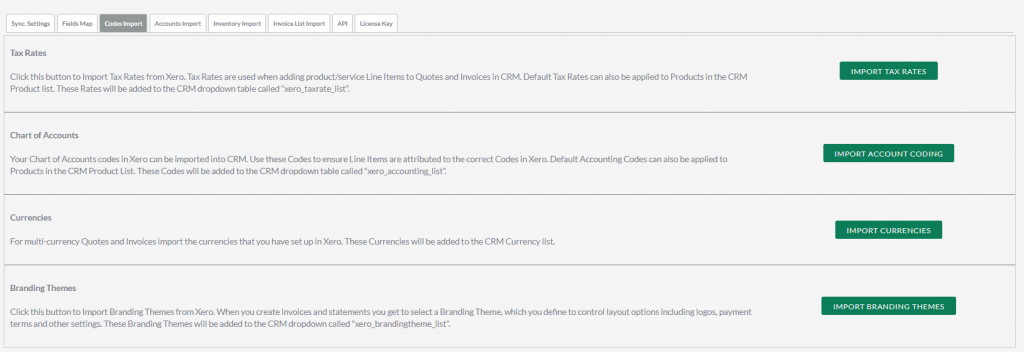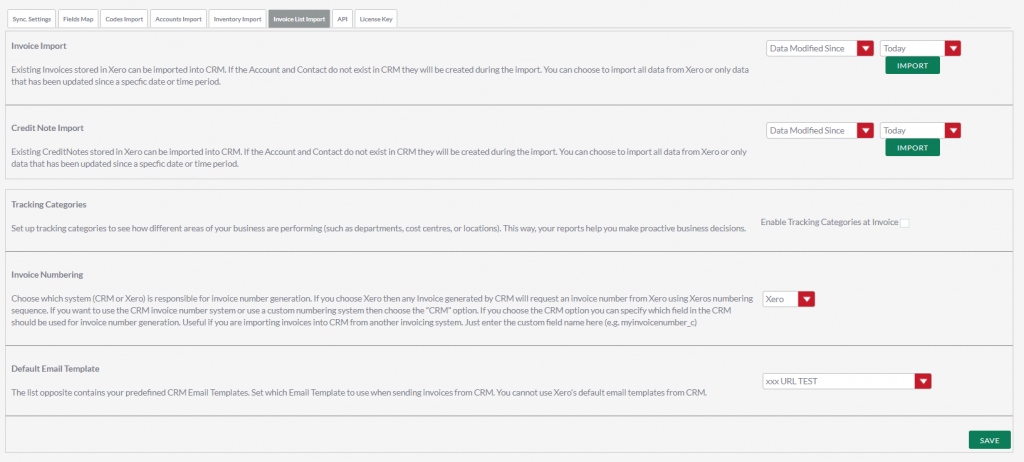Quick2Xero Set Up
Overview
Quick2Xero synchronises data in FibreCRM with data in Xero so that Accounts/Organisations, Contacts/People and Invoices can be generated in Xero and vice versa so that you don’t have to re-key in data. As information is updated in either CRM or Xero the updates are seamlessly transferred. For instance, you can convert an Opportunity in CRM to Invoice and have the invoice generated in Xero automatically. Payments and Credit Notes received into Xero are visible in CRM. CRM users (who may not have access to Xero) can create and send invoices and see aged debtor information.
Feature Summary
- Synchronizes Tax rates from Xero to CRM
- Synchronizes Currencies from Xero to CRM
- Synchronizes Chart of Accounts from Xero to CRM
- Synchronizes Xero Contacts to and from CRM (Accounts and Contacts)
- Synchronizes Xero inventory to and from CRM (Products)
- Synchronizes Sales & Purchase Invoices to and from Xero
- Synchronizes Payment and Credit Note history and status from Xero to CRM
- Synchronizes XERO Branding Themes
- Synchronizes XERO Tracking Categories
- For CRM Accounts you can set default Tax rates
- For CRM Products you can set default Tax rates
- Schedulers created for automating the transfer of data on a regular schedule, including:
- Create invoices in Xero from data added to CRM from external sources (e.g. direct data feed into CRM database from IRIS Fees ledger)
- Import new and updated Xero Invoices into CRM
- Import new and updated Xero Contacts into CRM
- Import new and updated Xero Inventory into CRM
- Import new and updated Xero Payments & Credit Notes into CRM
- Flexible field mappings facility in Admin. Pick which of your custom fields connect to fields in Xero
- Flexible invoice number options gives you the choice of whether to use Xero or CRM for automatic invoice number generation
Best Practice Advice – First Things First!
This module is designed to move large amounts of data between your finance package and your CRM package. The last thing you want to do is mess up your data by not defining all the options before the sync begins.
This section is designed to point you in the right places so that when the synchronisation starts everything goes into the correct place, duplicate checking is performed correctly and everything just works. Here’s what you need to consider:
- Don’t switch ON the sync until you have configured your options. By default all sync’ing is disabled so after installation and connection to Xero don’t forget to switch on sync’ing. Before you do switch on, you will want to be ready so make sure you set what data should sync and in which direction(s) so please read the remainder of this document carefully.
- Account Numbering is best practice. If you cannot rely on an exact match between the Xero Contact Names (businesses) and Accounts in CRM then use Account Numbering. Xero has a field for this. You can use any field you like in CRM but make sure you have selected the correct field to map to Xero’s Account Number field (See Mapped Fields section) and make sure you have entered the Account Numbers in both systems before you start sync’ing. If you have a lot of Contacts to update in Xero, Xero has a facility to allow importing of account numbers. https://help.xero.com/UK/ContactsAccountNumber . You can export from CRM your Accounts (name and account number) and use Excel to create a merged file which can be imported into Xero.
- Decide what should be sync’d. For example, you can sync Purchase invoices and/or Sales invoices. For instance, do you want all your purchases in Xero to be imported into your CRM Invoices module? Are you only using the integration for sync’ing Sales Invoices? Make sure you have selected the appropriate option in the config screen.
- Invoice Numbering. Which system is managing this? Do you want to use Xero for Invoice Number allocation or would you prefer that the CRM generates its own sequences? If you are importing invoices from a 3rd party source into CRM then which field are you using to store the Invoice number? Don’t forget to map this invoice Number field to Xero’s Invoice Number field so that the CRM checks for duplicates based on this number.
- Inventory Sync. When you create a new product in CRM the Item Code field checks to see if the Item Code is available in Xero. If it is already being used then the system will warn you. You can import Inventory from Xero in Admin Settings but do make sure you don’t create unwanted duplicates. The Account Codes and default Tax rates can be set for each Product in CRM (For both purchases and for sales). Where the Products have been imported from Xero Inventory these fields will automatically be populated. When creating a Quote in CRM and a user picks a Product line item, the tax rate and accounting code will auto populate if these Products have these codes set up or imported.
- Dropdown lists. When you import Tax rates and Account Codes etc. there may be many unwanted entries and the best thing to do is go to Dropdown Editor after the import and remove any unwanted items. This will make finding the right option easier for users.
- Email Invoice feature. Before you can use the “Email Invoice” feature in CRM you will need to set up an Email Template in CRM. Whilst the PDF invoice is generated by Xero (and attached to the email) the actual email is sent from the CRM and using your CRM email credentials. It is not possible to send from Xero via CRM. Head over to the Admin Xero Settings and pick an email template that should be used for this function. Additionally, be aware that it is not possible to Email a Draft Invoice and therefore the Email button is hidden when the Invoice is in a Draft state.
Deleting Items – What you need to know
Quick2Xero does not delete data in Xero. If you delete a record (e.g. an invoice) in CRM the record will remain undeleted in Xero.
If you set the ‘Status’ of an invoice to ‘Deleted’ in CRM, a warning message will be displayed to let you know that the status will not change in Xero. We recommend that if you need to delete an invoice then delete it in Xero. Not in CRM. Xero will update CRM and set the status in CRM to deleted.
Configuration Options
Once installed go to Admin and click on the Quick2Xero Settings icon
Use the TABS to configure different sync options.
Use the sync. Settings TAB to switch on/off the sync. After the installation of Quick2Xero the sync will be switched off. Do not switch it on until you have chosen what should sync.
You can switch the sync’ing off and back on at any time. For instance if you need to upgrade CRM or Xero is offline for a time.
Sync. Settings
Item | Dropdown Options | Explanation |
Sync Organisation | All your Xero Companies | Pick which Xero Company should sync with CRM |
Sync Direction | Two-way | Choose whether the sync is a one-way to two-way feed |
Sync CRM Accounts/Organisations | No | Create Xero Contacts from CRM Accounts/Organisations. Limit the type of Account that gets created in Xero |
Limit Sync CRM Accounts/Organisations | If Filter… above selected then show this field and options | Which Types of Accounts should sync to Xero |
Sync Xero Contacts | No | Create new Accounts in CRM when a Xero Contact is created and/or updated |
Sync Xero Products | No | Create new Products/Services in CRM when a Xero Inventory item is created and/or updated |
Sync CRM Products/Services | No | Create new Inventory items in Xero when a CRM product/service is created and/or updated |
Sync CRM Invoices | No | Create new Invoices in Xero when a CRM invoice is created and/or updated |
Sync Xero Invoices | No | Create new invoices in CRM when a Xero invoice is created and/or updated. Option to only sync back to CRM updates to invoices in Xero that were originally generated from CRM |
Sync Xero Payments and Credit Note Allocations | No | Create payments and credit note allocations in CRM that are created and/or updated in Xero |
Sync CRM Credit Notes | No | Create Credit notes in Xero when one is created and/or updated in CRM |
Sync Xero Credit Notes | No | Create Credit Notes in CRM when one is created and/or updated in Xero. Option to only sync back to CRM updates to credit notes in Xero that were originally generated from CRM |
Sync Xero Notes to Accounts/Organisations | No | Create a Note in CRM linked to the Account when a Note is created in a Xero invoice |
Sync Xero Notes to CRM Invoices | No | Create a Note in CRM linked to the Invoice when a Note is created in a Xero invoice |
Default Bank Account | Picklist of Bank Accounts in Xero | When CRM creates Payments which bank account are they entered into |
Importing Tax Rates, Codes, Currencies and Branding Theme
Importing Contacts to/from Xero
A Contact in Xero is sync’d to the CRM Accounts/Organisations module and not the Contact/People Module. Within each Xero Contact there are additional fields to store the primary person (firstname, lastname) and this information sync’s with the CRM Contacts/People Module.
The first time you link your CRM to Xero it is likely that your Customers and Suppliers already exist in Xero. Use this option to import these Businesses and People into CRM.
To avoid the potential for creating duplicates make sure you have mapped the Xero Account Number field with the correct CRM field (see Fields Map) and make sure each Xero Contact has an account number. If no Account Number is set then the de-dupe check will be carried out on the Name field (this requires an exact match).
Importing Inventory to/from Xero
Invoice Options
When you first connect Xero to your CRM you may want to Import some or all existing Xero invoices and credit notes into CRM. Use the Invoice Import utility to import invoices and their associated Contact.
You can switch on/off Tracking fields. Xero uses Tracking fields (https://help.xero.com/uk/Settings_Tracking) and CRM can be configured to use Tracking.






